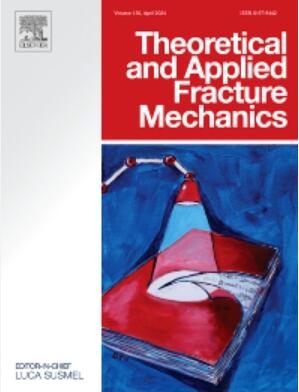Potential fracture behaviors of a crack tip under mixed Mode-II/III loading
IF 5
2区 工程技术
Q1 ENGINEERING, MECHANICAL
引用次数: 0
Abstract
Based on the three-dimensional geometrical modelling of multiple-crack initiations, present research demonstrates that there are four energy-based driving forces, which have different directions and different action regions or points around a crack tip under mixed Mode-II/III loading. These four energy-based driving forces compete to drive crack tip cracking and control the fracture configurations of the crack tip. By using the Griffith’s fracture criterion, when any one or two of the four energy-based driving forces reach the critical value of boundary cracking, a crack or two cracks will initiate in the form of crack kinking, symmetrical branching, side-branching or extension. There are multiple forms of the potential fracture configurations. The concerned fracture toughness and K-based fracture criterion for crack kinking and branching are found. The method to trigger crack branching is discussed. The notch effect on crack branching is investigated based on the present method.
求助全文
约1分钟内获得全文
求助全文
来源期刊

Theoretical and Applied Fracture Mechanics
工程技术-工程:机械
CiteScore
8.40
自引率
18.90%
发文量
435
审稿时长
37 days
期刊介绍:
Theoretical and Applied Fracture Mechanics'' aims & scopes have been re-designed to cover both the theoretical, applied, and numerical aspects associated with those cracking related phenomena taking place, at a micro-, meso-, and macroscopic level, in materials/components/structures of any kind.
The journal aims to cover the cracking/mechanical behaviour of materials/components/structures in those situations involving both time-independent and time-dependent system of external forces/moments (such as, for instance, quasi-static, impulsive, impact, blasting, creep, contact, and fatigue loading). Since, under the above circumstances, the mechanical behaviour of cracked materials/components/structures is also affected by the environmental conditions, the journal would consider also those theoretical/experimental research works investigating the effect of external variables such as, for instance, the effect of corrosive environments as well as of high/low-temperature.
 求助内容:
求助内容: 应助结果提醒方式:
应助结果提醒方式:


